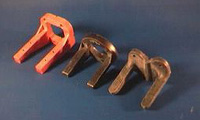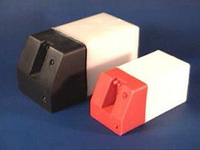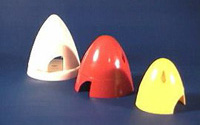

| Getting To Know About Accessories |
Engine Mount
Some aircraft use wooden bearers to which the engine is mounted while
others use a moulded nylon or aluminium mount. The wooden bearer would
usually be built into the airframe of a kit, while the moulded type is
usually bolted to the ply front plate commonly known as the 'Firewall'.
It is possible to get mounts specially for a particular engine although
many generic mounts are available to fit most engines. See 'Getting To
Know R/C Engines' for more detailed information on engine mounts. 
Fuel Tank, Fuel Tubing & Fuel Filters
Most kits will not have a fuel tank and related fuel tubing included.
These are available in many different sizes and should be chosen according
to the size of the aircraft its engine. Fuel tubing is usually made from
silicon and can be bought by the metre length. A fuel filter should be
fitted in the fuel lines from your fuel container to the tank and between
the tank and the carburettor.
Engine Accessories
When buying an engine for your aircraft, there will be a few items that
you will need that don't come with the engine or the aircraft. These include
the propeller. And sometimes manufacturers don't supply the glow plug.
I don't know why this is. It's like buying a tumble
dryer without the electrical plug. They don't work without one! A silencer
should be included with your engine. If not, don't buy it! Every aeromodeller
should ensure that their aircraft is well silenced and below the BMFA
guidelines of 82db at 7 metres.
 Spinner
Spinner
The spinner is the cone shaped object mounted to the engine prop shaft
on the nose of the aircraft. The spinner can be made from plastic or aluminium
and functions primarily to improve looks and aerodynamics but also rounds
out the sharp point of the engine's prop shaft and nut.
Covering
The covering of an aircraft is the skin which is stretched over the airframe.
On R/C aircraft it is usually a fabric or plastic film which is applied
with an warm iron. These covering will shrink when heat is applied thus
giving a taut durable finish. Plastic covering gives a shiny finish and
requires no further treatment. Fabric covering usually requires a coat
of paint to finish it and make it resistant to fuel and exhaust of the
engine. This is called fuel proofing. (You also have to ensure that the
paint you use is not affected by fuel or exhaust gasses). Covering materials
come on a roll and in many different colours and may be cut into rough
shape before being ironed onto the airframe.
Pushrods
The pushrods are part of the control linkage which connects the servo
part of the radio system to the control surfaces of the aircraft. Pushrods
are usually stiff pieces of balsa with threaded wire and clevises fastened
to each end.
Snakes, Bowden Cables
A flexible cable that takes the form of a wire or one plastic tube
running inside another with the ability to turn around corners. These
are generally made with a metal cable running inside a plastic tube and
are popular in controlling the engine throttle.
Control Horn
The control horn is small bracket mounted on a control surface to convert
the movement of the pushrod into the movement of the control surface.
Clevis
The clevis is a small fastener at the end of a pushrod, usually made
from nylon or metal, which connects the pushrod to the control horn. Clevises
may also be referred to as links or quick links.
Hinges
The hinges are used to connect the moveable control surfaces of the aircraft
to the fixed surfaces and allow smooth easy movement. They may take several
forms including hinge points, pinned hinges, or strips of thin Mylar plastic.
Foam Rubber
Foam rubber is used to wrap the radio receiver and receiver battery pack
in the plane so that they will be isolated from the vibration of the running
engine.
Wheel Collets
Wheel Collets are small metal collars fastened with a grub screw to
the axle of an aircraft on either side of the wheel. These stop the wheel
from coming off the axle or rubbing against the undercarriage.
Wheels
The wheels for an aircraft come in several styles including treaded, non-treaded,
scale tread, air-filled, and super lightweight. Most wheels are available
in sizes from 1.75" to 6" in 1/4" steps.